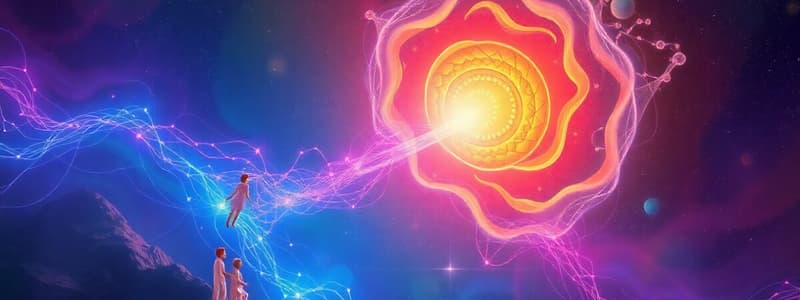Podcast
Questions and Answers
What critical process allows sensory receptors to communicate with the brain?
What critical process allows sensory receptors to communicate with the brain?
- Transduction (correct)
- Sensory adaptation
- Neural integration
- Synaptic transmission
If you close your eyes and apply pressure to your eyelid, you might perceive sparkly dots. What does this phenomenon demonstrate about perception?
If you close your eyes and apply pressure to your eyelid, you might perceive sparkly dots. What does this phenomenon demonstrate about perception?
- Sensory receptors can only be stimulated by their intended stimulus.
- The eye is more sensitive to pressure than light.
- The brain always accurately interprets sensory input.
- Perception occurs when sensory receptors in the eye are stimulated, regardless of the stimulus. (correct)
How do sensation and perception differ from one another?
How do sensation and perception differ from one another?
- Sensation is a conscious experience, while perception is an unconscious process.
- Sensation involves interpretation, while perception involves basic registration.
- Sensation occurs in the brain, while perception occurs in the sensory organs.
- Sensation is the stimulation of a sense organ, while perception is the organization and interpretation of that sensation. (correct)
What does the example of learning to read illustrate about the relationship between sensation and perception?
What does the example of learning to read illustrate about the relationship between sensation and perception?
What is the role of sensory receptors in the process of sensation?
What is the role of sensory receptors in the process of sensation?
If a person has damage to the visual processing centers of their brain, but their eyes are undamaged, what is the most likely result?
If a person has damage to the visual processing centers of their brain, but their eyes are undamaged, what is the most likely result?
Bees can see 'colors' that humans cannot. What does this tell us about sensory perception?
Bees can see 'colors' that humans cannot. What does this tell us about sensory perception?
Which of the following is an example of transduction?
Which of the following is an example of transduction?
What is the primary function of perception?
What is the primary function of perception?
Why can't humans sense magnetic fields, like those in an MRI machine, without specialized equipment?
Why can't humans sense magnetic fields, like those in an MRI machine, without specialized equipment?
The fact that bats can hear high-frequency sounds that humans cannot is an example of:
The fact that bats can hear high-frequency sounds that humans cannot is an example of:
Which of the following best describes the sequence of events in sensory processing?
Which of the following best describes the sequence of events in sensory processing?
What would happen if the process of transduction did not occur?
What would happen if the process of transduction did not occur?
In the context of sensory perception, what does the term 'mental representation' refer to?
In the context of sensory perception, what does the term 'mental representation' refer to?
What is the primary difference between how the eye perceives lines and curves on a page and how the brain perceives them when reading?
What is the primary difference between how the eye perceives lines and curves on a page and how the brain perceives them when reading?
If a person is able to detect a physical stimulus but cannot identify or interpret it, which part of the sensory and perceptual process is likely impaired?
If a person is able to detect a physical stimulus but cannot identify or interpret it, which part of the sensory and perceptual process is likely impaired?
Why is it important that each type of sensory receptor is uniquely sensitive to a particular type of energy?
Why is it important that each type of sensory receptor is uniquely sensitive to a particular type of energy?
Which of the following scenarios best illustrates the concept of perception, rather than just sensation?
Which of the following scenarios best illustrates the concept of perception, rather than just sensation?
In what way does the ability of some animals to sense stimuli that humans cannot (e.g., magnetic fields) challenge our understanding of reality?
In what way does the ability of some animals to sense stimuli that humans cannot (e.g., magnetic fields) challenge our understanding of reality?
A person describes seeing a flash of light after being hit hard in the eye. Although no light was present, the mechanical stimulus was processed as light. What process explains this?
A person describes seeing a flash of light after being hit hard in the eye. Although no light was present, the mechanical stimulus was processed as light. What process explains this?
Flashcards
What is Sensation?
What is Sensation?
The simple stimulation of a sense organ, involving the registration of light, sound, pressure, odour, or taste.
What is Perception?
What is Perception?
The organization, identification, and interpretation of a sensation in the brain in order to form a mental representation.
What is Transduction?
What is Transduction?
The process where sensory receptors convert physical signals from the environment into neural signals for the central nervous system.
Sensory Receptor Sensitivity
Sensory Receptor Sensitivity
Signup and view all the flashcards
Is perception direct?
Is perception direct?
Signup and view all the flashcards
Inaudible communication
Inaudible communication
Signup and view all the flashcards
Study Notes
- Sensation and perception are distinct processes, with sensation preceding and being transformed by perception.
- Sensation involves the simple stimulation of a sense organ, registering basic information like light, sound, pressure, odor, or taste.
- Perception occurs in the brain, involving the organization, identification, and interpretation of sensations to form mental representations.
- Sensory organs encode information, while the brain transforms it into coherent mental representations.
Reading as a Learned Skill
- Reading is a learned skill that transforms sensory information into meaningful words and concepts.
- Without learning, sensory information like lines and curves on a page would be meaningless.
- Brain damage can impair perceptual ability, affecting the interpretation of sensory information.
Sensory Energy and Transduction
- Sensory receptors communicate with the brain through transduction.
- Transduction is the process where sense receptors convert physical signals from the environment into neural signals.
- In vision, light reflected from surfaces provides information about objects.
- In hearing, vibrations cause changes in air pressure.
- In touch, pressure against the skin signals shape, texture, and temperature.
- In taste and smell, molecules reveal the identity of substances.
- Each sensory receptor is sensitive to a specific type of energy.
- The eye is sensitive to light, while the skin is sensitive to mechanical pressure.
- Physical energy is transduced into electrical signals by sensory receptors.
- Stimulating sensory receptors results in interpreted perceptions.
The Illusion of Perception
- Some animals can perceive stimuli that humans cannot.
- Bats, rats, and mice use high sound frequencies, while bees and butterflies see "colors".
- Humans can only see a small portion of electromagnetic frequencies because those are the frequencies for which we have visual receptors.
- Some animals navigate by sensing the Earth's magnetic field, which humans cannot sense.
Studying That Suits You
Use AI to generate personalized quizzes and flashcards to suit your learning preferences.




